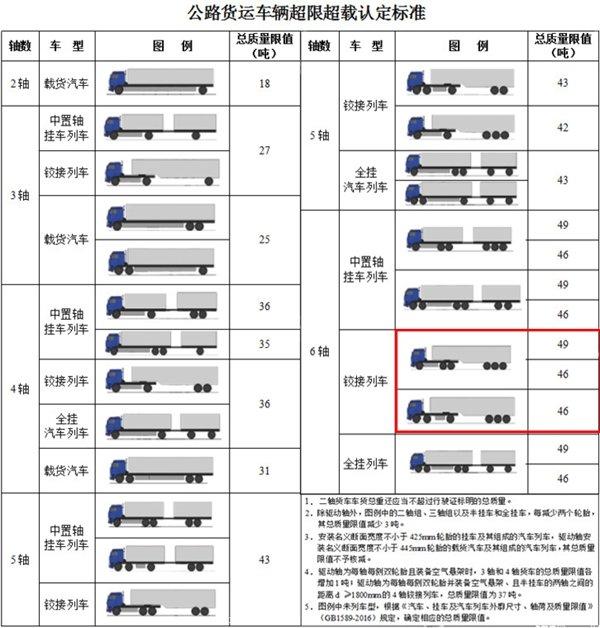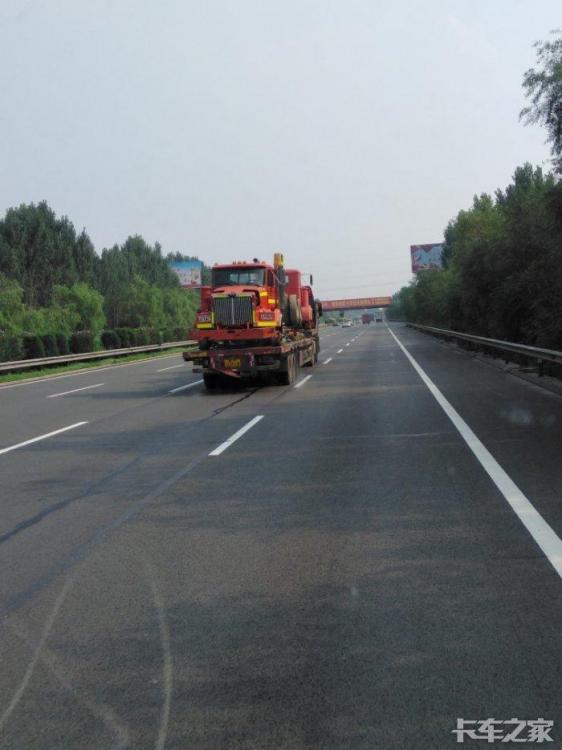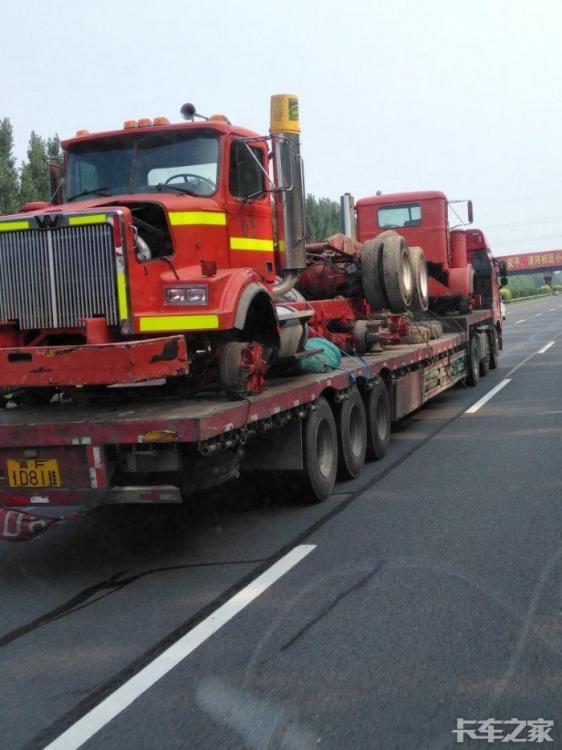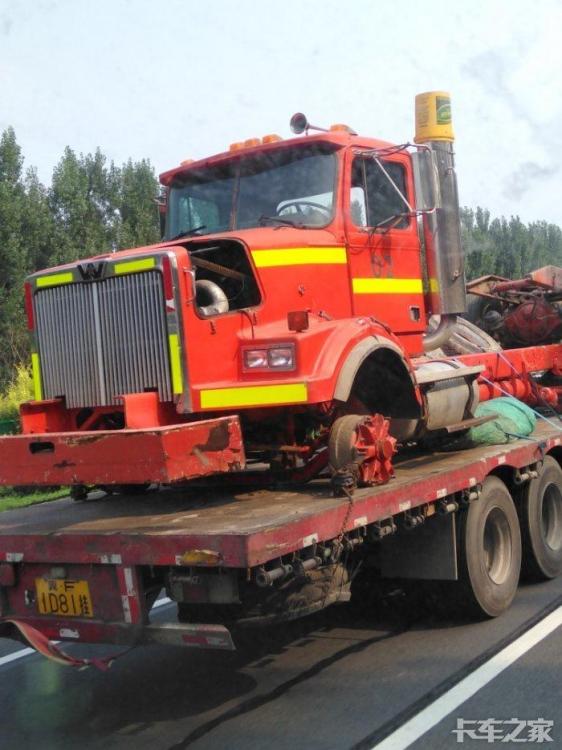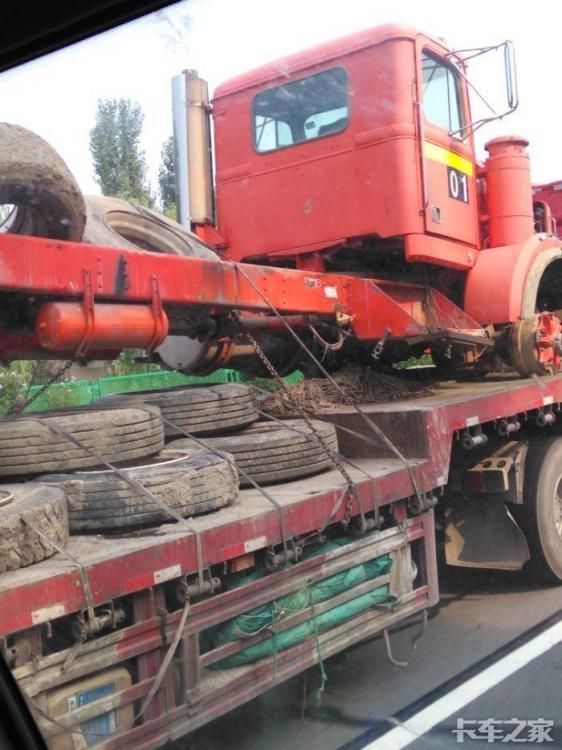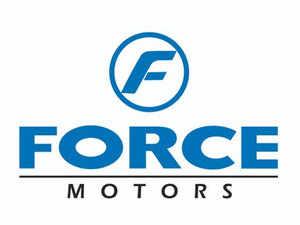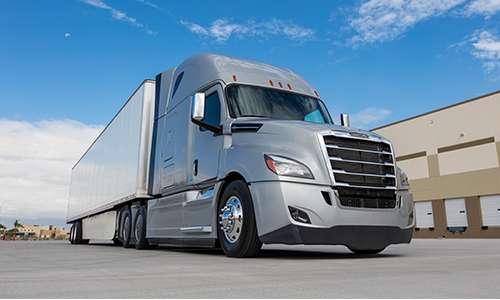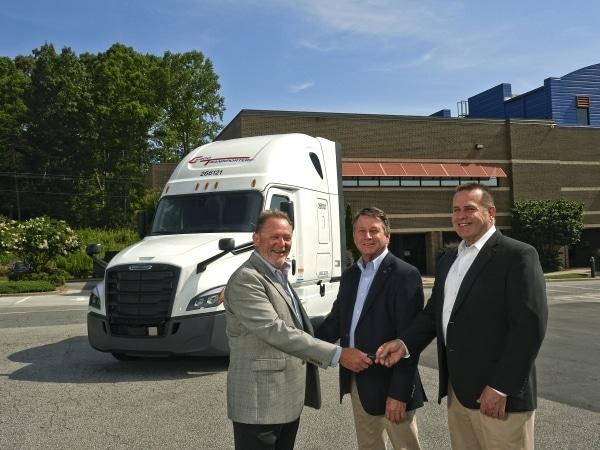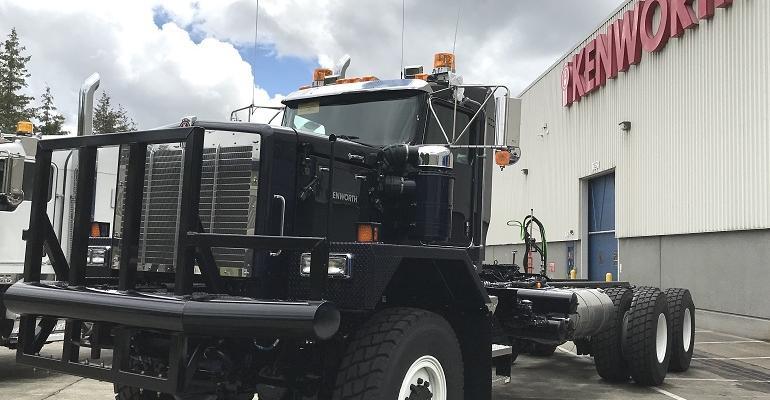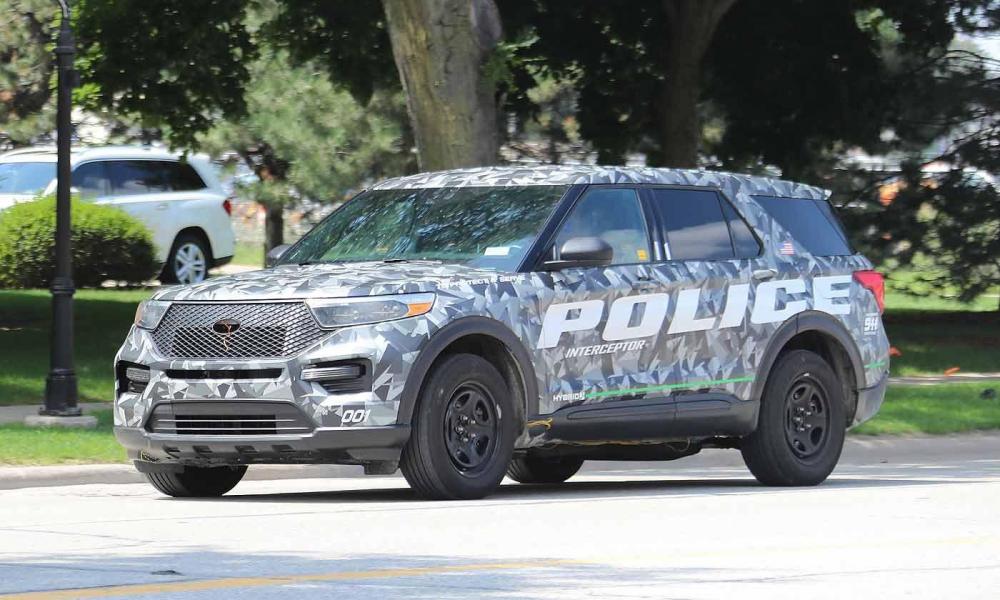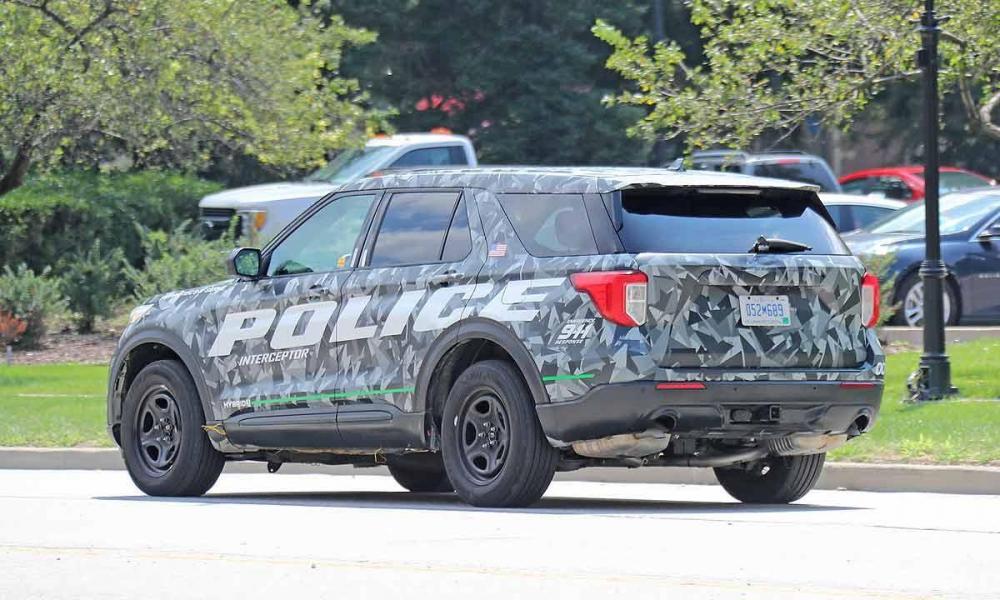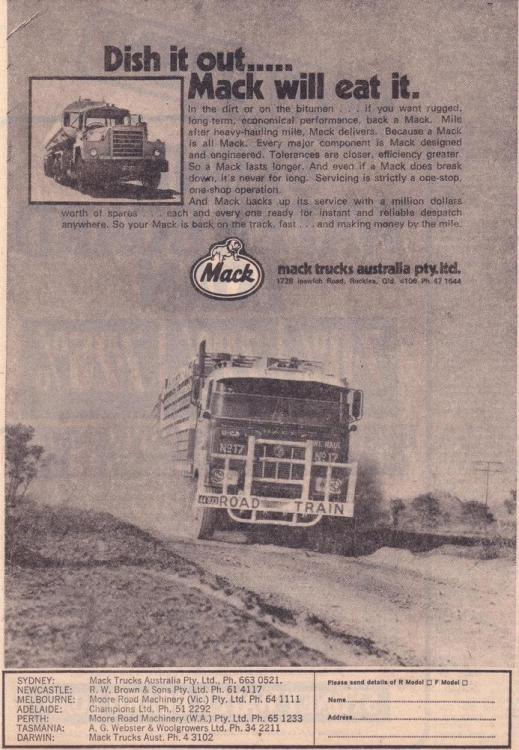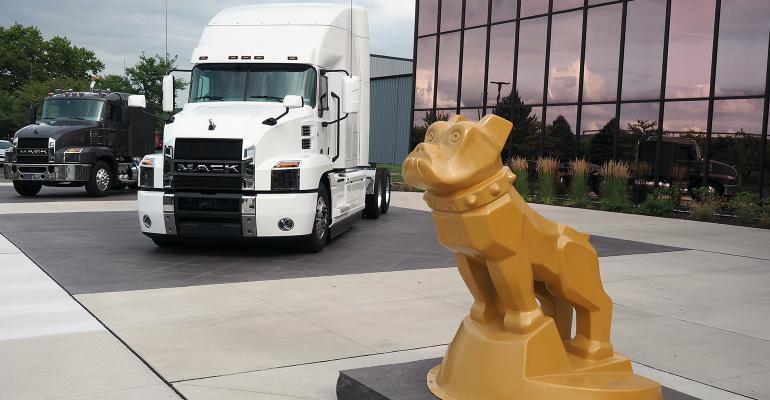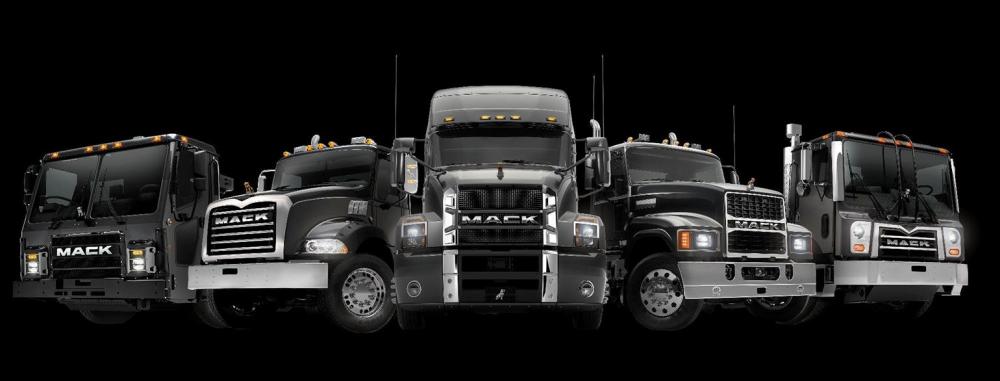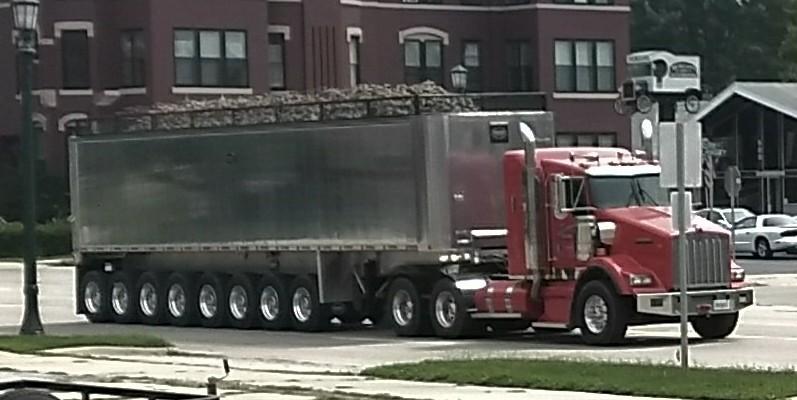
kscarbel2
Moderator-
Posts
18,550 -
Joined
-
Days Won
112
Content Type
Profiles
Forums
Gallery
Events
Blogs
BMT Wiki
Collections
Store
Everything posted by kscarbel2
-
A J6P 6x2 twin-steer tractor at the front and China (global) standard tri-axle trailer. Why the US doesn't use tri-axle trailers allowing 44 metric ton (97,003lb) loads escapes me. Beautiful modern highways. In China with a tri-axle trailer, a 6x2 twin-steer or 6x2 tag-axle configuration tractor can gross 46 metric tons (101,413lb), and a 6x4 can gross 49 tons (108,027lb). .
-
-
Shuddering while empty pulling hills
kscarbel2 replied to Bigl62's topic in Modern Mack Truck General Discussion
Ah, you're familiar with it. -
It's sad when you see that, and we've all seen it time and time again, sandblasted, primed (which is porous) and then parked outside. I have a love-hate relationship with sand. Glass beads is more friendly......if only you could fit it into a machine.
-
Shuddering while empty pulling hills
kscarbel2 replied to Bigl62's topic in Modern Mack Truck General Discussion
In Sweden, Volvo dealers sell an additive to address that. I don't know how to say in English. The bottle description is "Vakna och gå vätska". Maybe Volvo Trucks North America (VTNA) markets it under a different name. -
The world is approximately 4.54 (± 0.05) billion years years old. And we're told that mankind has only been on earth about 200,000 years. The average age of death is about 78. So considering the earth's age versus our time here, it's like checking into a hotel for less than one minute. We are mere guests here......we have no right to abuse it. Rather, we should show a great deal more respect. We're lucky to exist.....period, much less on an absolutely beautiful world, not to mention the only one (we know of) that supports life.
-
You are 5,000 percent correct !
-
Volkswagen Group owned MAN Trucks exits Indian market
kscarbel2 replied to kscarbel2's topic in Trucking News
Force Motors to acquire Man Trucks' Pithampur facility The Economic Times / August 23, 2018 Pune-based Force Motors today said it has agreed to acquire Pithampur-based manufacturing plant of German commercial vehicle maker MAN Trucks for an undisclosed amount. In a regulatory filing, Force said its board has accepted a proposal from MAN Trucks India to sell and transfer certain assets including immovable and movable properties as also other intangible assets at its plant at Pithampur (Madhya Pradesh). The arrangement is being recorded by binding agreements, it added. The arrangement would be subject to receipt of necessary approvals and it is expected that the actual transfer of the facility may happen by October end, Force Motors said. When contacted a MAN Trucks India spokesperson said: "MAN Trucks India and Force Motors Ltd. have entered into an agreement wherein Force Motors will acquire the Pithampur manufacturing facility of MAN. The agreement also entails continued employment for all MAN members at Pithampur." This development follows the announcement from MAN Trucks earlier in August to restructure its India operations, he added. The company however declined to divulge any details of the agreement, including commercials, with Force Motors. Earlier this month, the board of MAN Truck & Bus AG (MTB) had decided to restructure its India organisation as part of its global strategy to focus on premium segment markets. As a result, MAN Trucks India would now become an R&D Centre for Excellence supporting global projects. The manufacturing, sales and exports of the CLA range of heavy commercial vehicles will be stopped after the existing customer orders are completed. In July, the German company had announced putting on hold its ongoing projects, including new product launches and upgradation of models in the country to comply with the BS VI emission norms which come into effect from April 1, 2020. Man Trucks manufactured various products at the Pithampur plant including tippers for off-road and construction, haulage for regular and over dimensional cargo, and special application trucks such as fire tenders, garbage compactors, concrete mixers, boom pumps, tip trailers and bulkers. The company has sold over 25,000 trucks since it started India operations in 2006. . -
Brianna Jackson, Bloomberg / August 23, 2018 The next battleground for replacing fossil fuel-guzzling vehicles will be U.S. interstate highways, where long-haul trucks keep the economy moving. Electric trucks are coming, and they’ll be cleaner and cheaper to operate than conventional models that burn diesel, according to Tesla Inc., which already has prototypes on the road. Diesel advocates say range and recharging will be bigger hurdles for massive 18-wheelers than they’ve been for cars, and it will be several years before battery-powered models are ready for the open road. The shift comes amid a growing debate over U.S. vehicle emission standards. President Donald Trump is seeking to roll back limits, while California and other states are challenging the plan in the court. “Right now, we don’t think it’s viable,” said Jon Mills, a spokesman for engine maker Cummins Inc. Electric trucks are “more viable where you have shorter routes, less loads and you’re able to recharge.” The transition will have a significant impact on commerce and the environment. Trucks are the lifeblood of the U.S. economy, handling 71 percent of the food, retail goods, construction supplies and other freight delivered every day. They’re also a significant source of air pollution. U.S. greenhouse gases from medium- and heavy-duty trucks increased 85 percent from 1990 to 2016, according to the Environmental Protection Agency (EPA), accounting for about 23 percent of carbon emissions from transportation in 2016. While electric trucks will curb pollution, it’s not clear the industry is ready to switch, said Mills. For starters, long-haul truckers would need a place to recharge during cross-country trips. Plus, batteries are heavy, and adding weight cuts into the cargo truckers are paid to haul. Cummins supplies engines for vehicles including consumer pickups, fire engines, tractors and heavy-duty trucks. Most burn diesel and the Columbus, Indiana-based company has some that use natural gas. It’s also developing electric motors, but Mills doesn’t expect much demand for them in big trucks anytime soon. Diesel will be “the primary option for heavy duty trucking markets, long haul especially, for a decade or more,” Mills said in an interview. Tesla expects it sooner. The top electric car maker unveiled the Semi in November, a so-called Class 8 truck that can haul a maximum vehicle weight of 80,000 pounds, the standard size for long-haul shipping. It will go about 500 miles (805 kilometers) on a charge, with a base price of $180,000. A cheaper version will go 300 miles. Tesla plans to deliver production models next year and says Walmart and PepsiCo are among customers that have already placed orders. Tesla CEO Elon Musk said during the November introduction that the Semi costs about $1.26 per mile to operate, compared with $1.51 a mile for diesel models. Diesel backers question Tesla’s claims. “It’s easy if you’re just coming into this market to say ‘they’re $1.50 per mile and we can do it for $1.20,’ said Allen Schaeffer, executive director at the Diesel Technology Forum trade group [lobbyist]. “But where’s the proof? I haven’t seen it.” Diesel trucks are well entrenched in the shipping industry, and there’s little need for a new entrant, Schaeffer said. The industry has made significant advances in reducing pollution. According to EPA estimates, emissions from current engines are about 85 percent lower than before 2007, when new standards took effect. “Diesel is the benchmark for energy efficiency,” Schaeffer said. “Diesel dominates the entire sector.” There are other issues that concern truckers. A 500-mile range is fine for shorter delivery routes but diesel trucks typically go much further before refueling, sometimes more than 2,000 miles. Also, some drivers get paid by the mile, and wouldn’t make money while batteries recharge. Tesla said it’s planning a high-speed truck Megacharger that, in about 30 minutes, would give a battery enough juice to go 400 miles. Thor Trucks Inc. is also developing electric trucks, but the Los Angeles-based company is focusing initially on shorter delivery routes. United Parcel Service is testing a medium-duty vehicle now. Thor announced a Class 8 in December. CEO Dakota Semler said he’s already got orders. The ET-One is aimed at customers with shorter delivery needs. It will have a top range of 300 miles and a base price of $150,000. The company said the battery can fully recharge in 90 minutes. “If you’re able to produce a vehicle that would save fleets money, there’s really no reason why you’re not able to adopt more of them,” Semler said in an interview. Electric trucks are slowly gaining momentum, said Don Ake, vice president of commercial vehicles at FTR Transportation Intelligence. They’ll enter the market next year, and he said they would be a more competitive option in about five years. “There’s going to be a competitive battle at some point,” said Ake. “Diesel isn’t going down without a fight.”
-
Matt Cole, Commercial Carrier Journal (CCJ) / August 13, 2018 Approximately 435 model year 2019 Freightliner Cascadia trucks are being recalled over potential problems with certain Continental tires, according to documents from the National Highway Traffic Safety Administration. One recall affects approximately 425 of the trucks equipped with Continental Hybrid HS3, size 11R22.5 Load Range G tires. The recall from Daimler Trucks North America states the tire cords may be visible through the innerliner in these tires, which could cause a sudden loss of air. A separate recall affects only about 10 trucks equipped with Continental Coach HA3, size 315/80R22.5 157/154 L tires with the same issue. DTNA says it will begin notifying owners on Sept. 15, and Continental authorized service facilities will inspect and replace the tires for free. Owners can contact DTNA customer service at 1-800-547-0712 with recall number FL-778 or FL-779, or Continental customer service at 1-888-799-2168. NHTSA’s recall numbers are 18V-478 and 18V-479.
-
Matt Cole, Commercial Carrier Journal (CCJ) / August 20, 2018 Daimler Trucks North America is recalling more than 45,000 Freightliner Cascadia tractors for an issue with the ignition control unit not performing required bulb checks on the instrument panel in certain situations, according to documents from the National Highway Traffic Safety Administration. Daimler says if the ignition in the affected trucks is turned from on to off to on too quickly, the ICU may not perform the required bulb checks for the anti-lock brake system or electronic stability control, as required by the Federal Motor Vehicle Safety Standards. Without an ABS or ESC bulb check, the driver could be unaware that the warning bulbs are not working. In total, 45,667 model year 2017-2019 Freightliner Cascadia trucks manufactured between May 3, 2016, and July 11, 2018, are included in the recall. Daimler will begin notifying owners on Sept. 17, and dealers will reprogram the ICU’s to ensure a bulb check is performed each time the ignition is turned on. Owners of affected trucks can contact DTNA customer service at 1-800-547-0712 with recall number FL-780. NHTSA’s recall number is 18V-491. .
-
Truck News / August 22, 2018 PORTLAND, Oregon – Freightliner has delivered its 50,000th New Cascadia since it entered production in January 2017. The truck was delivered to Claremont, N.C.-based Cargo Transporters, which added its 128th new Cascadia upon the delivery. “Our goal was to develop a truck with our customers in mind and provide them with the very best in fuel efficiency, safety and driver-focused features,” said Richard Howard, senior vice-president of sales and marketing for Daimler Trucks North America. “We want to sincerely thank all of our customers for the continued trust and partnership, and we could have never reached this significant milestone without them.” Cargo Transporters currently operates more than 550 Freightliner trucks produced by the Cleveland, N.C., truck manufacturing plant. .
-
New Mack Trucks president: It's 'not if we spend more, but where do we spend more next' at Lower Macungie plant Jon Harris, The Morning Call / August 22, 2018 Martin Weissburg became president of Volvo Construction Equipment on Jan. 1, 2014, taking the helm of the second-largest segment within the Sweden-based Volvo Group at a time when the low-performing business had marginal sales growth and weak earnings. Fast-forward to the end of 2017. That’s when Volvo Construction Equipment boasted a 31 percent sales increase and its operating margin, a key measure of profitability, grew to 11.9 percent — top among its peers. With the turnaround complete, Weissburg was ready for his next task — one that would bring him closer to where he grew up in Maryland. So when the position of Mack Trucks president became available, the 56-year-old said he quickly raised his hand for what he considers “the cherry on top” of a career based in the heavy equipment, truck and trailer industry. Weissburg officially assumed the top job at Mack on June 1, though he arrived in the United States in January and worked closely with Dennis Slagle, who had led Mack since 2008. Weissburg joins Mack at a good time, with the truck maker in recent years pumping $3 million into its Allentown customer center, another $84 million into its Lehigh Valley Operations assembly plant in Lower Macungie Township and millions more into marketing and partnerships, such as the match-made-in-marketing-heaven deal with Oakland Raiders star Khalil Mack. Business isn’t bad either. Mack is taking in more orders this year, largely on the strength of its new highway truck, Anthem, that was unveiled in September and hit the assembly line in Lower Macungie this year. But Mack, like most of the trucking industry, is grappling with supply chain constraints as parts suppliers try to keep up with the hot market. As such, Mack has a backlog of orders that company officials say is longer than they would prefer. The company employs about 2,400 people at its Lower Macungie plant, an all-time high for that facility, which completed its first highway truck Nov. 19, 1975, with a 700-strong workforce. Weissburg said the plant added another “many dozen” over the course of the summer. Looking forward, Weissburg said he expects the robust demand for Mack products to continue for at least a few more quarters as 2019 also is shaping up to be a strong year. But inevitably, he noted, there will be a correction downward in the cyclical heavy-duty truck market, though it’s not clear yet when that time will come. The truck market, supply chain constraints and the company’s Lower Macungie plant were among the topics Weissburg discussed Monday at the Mack Customer Center in Allentown during a question-and-answer session with reporters. Here are excerpts from the session: Q: Are you building on market share in the highway segment? A: Absolutely. We’re building significant share. Again, it’s from a position lower than we wanted to be historically but you can say from that position, there’s significant opportunity for us to gain highway share. By virtue of the Mack Anthem, we have gained share in the highway segment, and we’ll continue to gain share in the highway segment. When you spend the money and time developing a product like the Mack Anthem, it’s not to sit back and hope it goes OK. It’s to play offense, and that’s what we’re doing. Q: Are there particular supply constraints that are holding you back? A: We have our share of challenges and a stretched supply chain, as well. … Without getting into the details, because I won’t, there’s no single major point of pain. Just right when you fix one, there’s another one point of pain sometimes that pops up. I’m close also with our suppliers, and I empathize with their challenges. The market is very hot, strong demand on component suppliers, castings. And, I’d say less so for us but more so for our suppliers, it’s very difficult to attract skilled labor to some of our suppliers. I think a lot of them have the ability and capacity as well from a fixed-asset standpoint, but from a labor standpoint, a lot of them are really stretched thin. We work very closely with our suppliers to make this happen. One of the benefits of being part of a very large, very strong, very well-managed global group is that we have a global supply chain and we leverage that, I think, pretty darn well. Q: How do you maintain quality when there’s a boom and there’s pressure to get them out the door? A: We never ship something until it’s ready to be shipped. And we never rush it. I’d rather be a day or two or more late and make sure it’s the quality of a Mack truck. Q: So you don’t just speed up the line? A: No, sir. That’s the last thing we would do, because that’s just asking for problems on the back end. If anything I’d rather slow the line down by X percent to ensure we have Mack quality and maybe have to push the delivery. The Mack brand promise carries a certain expectation of quality, reliability, durability. One of the greatest joys I get, and I’ve only been in my current role for a few months, is looking on the highway or looking on the job sites and see: How old is that Mack truck that’s pulling the dirt trailer? That’s one of the greatest joys I get. Trust me, we love to see them trade it in and buy a new one, don’t get me wrong, but it’s that reliability and durability of Mack, and it all starts with the quality designed in and the manufacturing quality before it ever leaves the plant. Q: Could you talk a little bit about the core of the operations that are in the Lehigh Valley and the future of the operations here? A: When we think of Mack Trucks, we think of the Lehigh Valley. For us, we can’t separate the two. This is our ancestral home. The company got started in Brooklyn in 1900 and moved here in 1907. Terrific workforce for all those generations. We continue to invest in the facility here. It’s the only Mack factory as far as truck manufacturing. So by definition, we are in partnership with the Valley and our employees. We are very invested, not just in the facility, not just from a financial standpoint, but as a community member and a citizen. Q: Where is everything at with the $84 million investment in the Lehigh Valley Operations (LVO) plant? Is everything completed, running as efficiently as it should or is there still some work to be done? A: In my prior position, I had 15 factories located around the world, so I will tell you that none of my factories are ever running as efficiently as we would like them to be. The LVO plant has made just very impressive improvements in productivity and efficiency and culture over the years. Every factory, every operation, including the executive office, always has room for improvement. The $84 million, that’s what has been invested to date recently. That’s not earmarked for future investment. That’s what we’ve already spent, and we’ll continue to spend as needed. There are always needs in a factory for additional spending. I won’t go into the details of that now, but I had a meeting earlier [Monday] and ones [Tuesday] at the factory, where we’re talking about not if we spend more, but where do we spend more next because you have to maintain state-of-the-art technology and facilities and keep moving things forward. We will continue to do that here in the Lehigh Valley. Q: Is there still capacity at the Lehigh Valley Operations plant? Could Mack need another plant down the road? A: Right now, we’re well-invested and, I would say in the capacity that we have in all of our facilities, things are working well. It’s hard to forecast the future, but there’s ample room in the LVO factory right now. Q: Is it kind of landlocked over there? A: It’s a bit landlocked, not as much as you think. In an industrial setting, we’re working and our local leader, Rickard Lundberg, is doing a very good job of efficiency and productivity improvements. You can have the same footprint but as you do things differently and even in a smarter and smarter way, you can get more productivity out of the same square footage. That’s what the team there has been doing successfully, and there’s always room for improvement on that still. Video - http://www.mcall.com/business/mc-biz-mack-trucks-president-martin-weissburg-visits-allentown-20180814-story.html#
-
“My whole career has been with trucks, trailers, construction equipment,” he said I don't see any background in trucks. He's a finance guy, with zero background in commercial truck R&D, manufacturing, sales and after-sales, parts distribution, service....... Source - Bloomberg..............https://www.bloomberg.com/profiles/people/16704218-martin-weissburg Career History President Mack Trucks Inc, 6/2018-PRESENT Senior Advisor Volvo AB, 1/2018-PRESENT Exec VP/Pres: Construction Equipment Volvo AB, 3/2016-12/2017 President Volvo Construction Equipment SA, 1/2014-12/2017 President Volvo Financial Services, 5/2010-1/2014 President:Americas Volvo Financial Services, 2005-5/2010 President Woodard LLC, FORMER President Great Dane Financial, FORMER Mktg Management Trainee Caterpillar Inc, FORMER Expensive bottled water, San Pellegrino and Perrier........to impress? Source – The Morning Call……. http://www.mcall.com/business/mc-biz-mack-trucks-president-martin-weissburg-visits-allentown-20180814-story.html# MARTIN WEISSBURG Title: Mack Trucks president and member of the Volvo Group executive board. Also, the senior Volvo Group executive in North America. Age: 56 Home: Greensboro, N.C. Background: His career began with Caterpillar Inc. when he was recruited to take part in the company's management trainee program upon his graduation from Purdue University. After getting his MBA from George Washington University, Weissburg went on to be president of Great Dane Financial and then president of furniture maker Woodard LLC. He joined Volvo Group in 2005 as president of Volvo Financial Services America, later becoming global president and CEO of Volvo Financial Services from 2010 to 2013. From 2014 to 2017, he was president of Volvo Construction Equipment. Truck background?
-
Mack's New Top Dog Addresses Company Successes and Challenges John G. Smith, Today’s Trucking / August 22, 2018 Though just recently named president of Mack Trucks, Martin Weissburg is no stranger to the trucking industry. “My whole career has been with trucks, trailers, construction equipment,” he said during a broad-ranging discussion with media at the company’s customer center in Allentown, Pennsylvania. He was named president June 1, succeeding Dennis Slagle, who had been in the role since 2008. Before that, Weissburg held senior and executive positions with the Volvo Group, including president of Volvo Construction Equipment in Europe, president and CEO of Volvo Financial Services, and president of Volvo Financial Services America. Having grown up in Maryland near Mack's headquarters in Pennsylvania, Weissburg described his new position with Mack is "the dream job." The company has seen improved sales as a result of the economic boom, as well as the success of the Mack Anthem, which helped the company gain share in the highway segment. Sales for models with 70-inch sleepers have doubled in comparison to last year. "It couldn't have come at a better time," Weissburg said. "The highway segment is just smoking." Production at the company’s Lehigh Valley Operations facility is now at an all-time high, with 2,400 employees, including 400 personnel added since last year last year. The booming economy presents its own challenges, though, as it has with other manufacturers. “Generally speaking, we’re in an environment where costs are up,” he said, referring to the prices of raw materials like steel and aluminum as an example. Not all of those increases are related to Trump administration tariffs. But the tariffs have created an environment that has seemingly given every supplier permission to raise prices. Labor demands are adding price pressures of their own, with industrial jobs at a 17-year high and more open jobs than there are applicants. “Logistics costs are up for everyone,” he added. Even those who make the trucks are paying more for those services. “We have our share of challenges in the supply chain as well,” Weissburg said, referring to constraints that keep build rates from growing at a faster rate. “There’s no single, major point of pain. Just right when you fix one, there’s another one.” To push Mack forward, the company continues to make new investments, primarily geared toward maintenance. Certified Uptime Centers and over-the-air engine updates are meant to cut down maintenance time and address preventative maintenance issues. Mack is also looking toward electrification, with plans to demonstrate an electric Mack LR refuse truck for the New York City Department of Sanitation in 2019. "This is coming," Weissburg said. "We can envision a fully electric site in the future." .
-
Trailer-Body Builders / August 22, 2018 Kenworth Truck Company’s assembly plant in Renton, Washington recently celebrated its 25th anniversary. Kenworth employees and their family members marked the anniversary in conjunction with Kenworth Family Day held at the plant. The event included antique Kenworth trucks, an employee classic car show, plant tours, a City of Renton fire truck, and much more, the company said. “More than 1,300 people from across PACCAR attended Kenworth Family Day, which was a great way to celebrate our employees and the plant’s 25th anniversary,” said Bart Hoemann, Kenworth’s Renton plant manager. “Kenworth Renton employees had an opportunity to showcase their workplace to their families, have some fun, and enjoy all the activities and food. Employees are critical to the plant’s success with the quality, innovation, technology and care they build into every Kenworth truck produced here.” Kenworth opened the 300,000 square-foot plant in 1993 on a 40-acre site in Renton. The plant’s first truck, a Kenworth T600B – a later version of Kenworth’s first aerodynamic truck – was presented to Stevens Transport. In 2000, Fortune magazine recognized the Renton plant as one of America’s Elite Factories, and the plant received Assembly Magazine’s inaugural Assembly Plant of the Year Award in 2004. A year later, Kenworth Renton had the honor of producing the 700,000th Kenworth truck in company history. In the past 25 years, the Renton plant has produced more than 144,000 Kenworth trucks. The plant currently produces the T680, T880, T800, W900, C500, K500 and 963 models, along with medium duty Kenworth T370s and T440s. Nearly 20 percent of the plant’s current employees have been working for Kenworth since the plant opened. “Kenworth’s long-term success in the trucking industry can be traced back to a philosophy established early in the company’s history,” Hoemann said. “Build the right Kenworth truck for each customer’s application, and build that truck to last. “That philosophy continues today at the Kenworth Renton plant.” .
-
Ford's 2020 Explorer breaks cover as pursuit vehicle Automotive News / August 22, 2018 The best look yet at the redesigned 2020 Ford Explorer crossover, one of the top-selling U.S. light trucks, emerged Wednesday when a photographer captured images of the next Ford Explorer Police Interceptor Hybrid nearly undisguised on the streets of Dearborn, Mich., home to the company's chief engineering center. Ford released a teaser image and details of the 2020 Police Interceptor in June with lights glaring in the dark, but little detail could be made of the image. The redesigned 2020 Explorer will share the same rear-wheel-drive platform, with optional all-wheel drive, as the all-new 2019 Lincoln Aviator. The Aviator was introduced at the New York auto show in April but Ford hasn't indicated when the next-generation Explorer will be unveiled. Ford declined to comment on the latest Explorer Police Interceptor Hybrid photos but said late Wednesday it will "have more to say on the all-new Explorer for retail customers later." U.S. sales of the Explorer have dropped 3.6 percent this year to 151,488 but it remains the top-selling large crossover, though the segment has grown 12 percent behind higher demand for the redesigned Chevrolet Traverse and Buick Enclave, the Toyota Highlander and Mazda CX-9, and the all-new Volkswagen Atlas and Subaru Ascent. Based on the latest photographs, the Explorer Interceptor features a more rakish profile, a plastic mesh-esque grille, sharper headlights and sculpted LED fog lights. From the side, it appears the Explorer receives a tighter greenhouse, sharper C-pillar and a revised character line that now flows through the door handles. The D-pillar has been reworked with a more aggressive angle. The tailgate, bumper and taillights also appear more angular. The 2020 Explorer Interceptor will feature additional cargo capacity while passenger volume will remain flat, according to Ford's website. .
-
Delphi Technologies PLC (DLPH), the popular fuel injection supplier for Volvo and Mack-badged Volvo engines, set a 52-week low today of $37.44 on abnormally high volume. Their 52-week high was 104.09. Interestingly, today was an up day for the market...........the number of companies hitting 52-week lows on the NYSE and Nasdaq was quite low. On another note, Ford (F) has bounced somewhat off the bottom, closing the day at $9.69.
-
Mack Trucks - Sales Marketing
kscarbel2 replied to kscarbel2's topic in Modern Mack Truck General Discussion
-
Aaron Marsh, Fleet Owner / August 21, 2018 ALLENTOWN, PA. Has the North American Class 8 truck market—which hit a record high for orders last month—peaked? It's possible, speculates Martin Weissburg, the new president of Mack Trucks, but for now, every indication is that demand will stay very high for at least a few quarters. And 2019 is looking likely to be a strong year for the market as well, the OEM predicts. Weissburg took the reins at Mack on June 1, which he calls "the dream job of a career based in the heavy equipment industry," and says he and the company are keeping in close tabs with suppliers to be sure there's enough parts to keep the assembly lines rolling. The company isn't experiencing any shutdowns, but that requires constant vigilance. "We have our share of challenges in a stretched supply chain. Mack Trucks is not immune to that," he told reporters in a meeting yesterday at the Mack Customer Center. "Just when you fix one [potential supply problem], there's another pain point that pops up." On that note, he said Mack's truck production at its Lehigh Valley Operations in Macungie, PA, which boasts some 2,400 employees, "is at an all-time high" and the facility is putting out as many trucks as it can. Instead of speeding things up any further to get more trucks out the door, though, "if anything, I'd rather slow the line down to ensure quality," Weissburg noted. "We never let a truck out that's not ready." He added that with competition extremely high among OEMs, any compromise in quality and decrease in truck reliability would only come back to haunt you. "We view any truck down as a crisis," Weissburg said. To help with that, since any truck lineup will have breakdowns, Mack's Uptime Center in Greensboro, NC takes calls and assists 24/7 if a Mack truck has a problem. That relatively new facility and service are part of what Mack sees as essential to new truck sales going forward, according to Jonathan Randall, senior vice president of North American sales at the company. He said Mack has been testing out over-the-air updates with "several hundred" trucks from across Mack's lineup. Rather than having to bring a truck in to a dealership, OTA service can handle a variety of things like software fixes and updates and can be scheduled when the driver has some available time. As it's currently set up, the truck's ignition is switched off and back to "on" and the update/ service can be performed. Mack began working with OTA service after studying truck repairs. The OEM found that the average time in the shop for trucks was four days, but the average repair took only four hours. So there's an opportunity to save fleets and drivers considerable expense by avoiding that shop visit. "It's all about limiting breakdowns, but when downtime or dwell time occurs, it's about making it as little as possible," Randall said. With increasing computerization of heavy trucks, OTA service and updates are one approach to solving the problem. The follow-up after the sale has also become a key point in this market for OEMs to differentiate themselves. "Buying a Mack truck is not just a point-in-time purchase," Weissburg said. "We're a relationship company, not just a vendor of trucks." Mack has invested some $3 million in its Allentown Customer Center in the last few years and another $80 million in the Lehigh Valley Operations truck assembly plant. That's not a static thing: "There's always the need to spend more in a factory," Weissburg noted. Mack's dealer network has also been making sizeable investments in shops, personnel, parts, and facilities, according to the company. All those elements of the supporting network have come to bear in this year of very high market demand. Weissburg also contended Mack has been well-positioned with its product portfolio, including a fresh on-highway offering with the launch of the Anthem tractor last fall. It made for good timing, although he pointed out the company might've wished the launch came about six months earlier. He said demand for the Anthem "has exceeded all our expectations." While he didn't get into specific figures, he and Randall said Mack has had twice as many orders for on-highway trucks so far this year than the number of those trucks the company delivered in all of 2017. On-highway was a weaker point for Mack prior to this, and it's an area the OEM is looking to grow its market share. Randall noted that on-highway trucks is where all the frenzy has been this year in terms of truck-buying—so much so that other areas like construction, where demand has been more level, have shrunk as part of the overall sales equation. Still, another big part of Mack's sales continues to be the Granite, which has also seen recent updates and can be spec'd as a dump truck, mixer, tractor, and other configurations. Also in terms of future preparation, Mack announced this spring it would begin testing a fully electric LR refuse truck with the New York City Dept. of Sanitation. "The first prototypes are in the works, and we're going to bring that out in late '19, early '20 for the first demo units," Weissburg said. "This is coming," he added. "The conventional wisdom is that start-stop operations like refuse are going to be an absolute winner for electrifying trucks." Mack hasn't released its predictions for the Class 8 market next year, but Weissburg said the company expects it will be another strong one. There are, however, forces that could constrain things. That includes tariffs on materials needed to build trucks, he noted, and even if a manufacturer's particular supply lines aren't affected directly, "the tariffs have created an environment for other suppliers to raise their prices," Weissburg said. "So there's price pressure upwards," and overall costs could increase. The labor market is also extremely tight, he added, with industrial jobs at a 17-year high. "We feel very fortunate we've been able to attract and retain the talent that we have," Weissburg said. While Mack dealerships have made investments and upgraded facilities, he said "they have their challenges" with labor as well, such as finding and keeping the best technicians. And of course, it's still difficult to fill all the driver's seats of those trucks—no matter how strong fleet orders and freight demand might be. The industry is short about 50,000 drivers overall, Weissburg noted, and that figure is poised to double. On that note, he said the Anthem has done well. Though the truck "is a business tool and its first job is hauling freight," fleets that have purchased it have been able to use it as a driver recruitment tool at hiring events, he argued. "We've had customers put it out front and say, 'If you come and work for us, you can drive that truck,'" Weissburg quipped. .
-
WSGW / August 22, 2018 Motorists can expect to see more big trucks on the road with the opening of the annual sugar beet harvest. Farmers across the 13 county area around the Great Lakes Bay Region started to harvest their crop Sunday and are taking the beets to Michigan Sugar processing plants in Bay City, Caro and Sebewaing. Drivers should remember to allow the truck extra room as drivers need to make wide turns at corners. Safety experts say when trying to pass one of these sugar beet trucks, if you can’t see the truck’s outside rear view mirror, the truck driver can not see you. Drivers need to drive with care around farm fields too as trucks coming out of a field may leave dirt and mud on the road. .
-
Mack Australia always has better looking and higher quality grilles and hoods.
-
Your truck indeed is a piece of Mack history that must be preserved (stored indoors at all times). While the CAS58 F-model two-man double bunk (high roof) cab was common on FMs shipped overseas, it was never sold in the US market.
-
So you have an oddball truck, 1 of only 15 made with disc brakes. And it does not have the standard M917 Rockwell axles, 20,000lb FDS-1807 front and 58,000kb SUHD bogey. Any casting numbers on the rotors? I would call the folks at Axletech...877-877-9717 (a descendant of Rockwell International, the auto business was spun off forming Meritor). Axletech is small enough they might provide the materials list (BOM) for that order.
-
BigMackTrucks.com
BigMackTrucks.com is a support forum for antique, classic and modern Mack Trucks! The forum is owned and maintained by Watt's Truck Center, Inc. an independent, full service Mack dealer. The forums are not affiliated with Mack Trucks, Inc.
Our Vendors and Advertisers
Thank you for your support!


